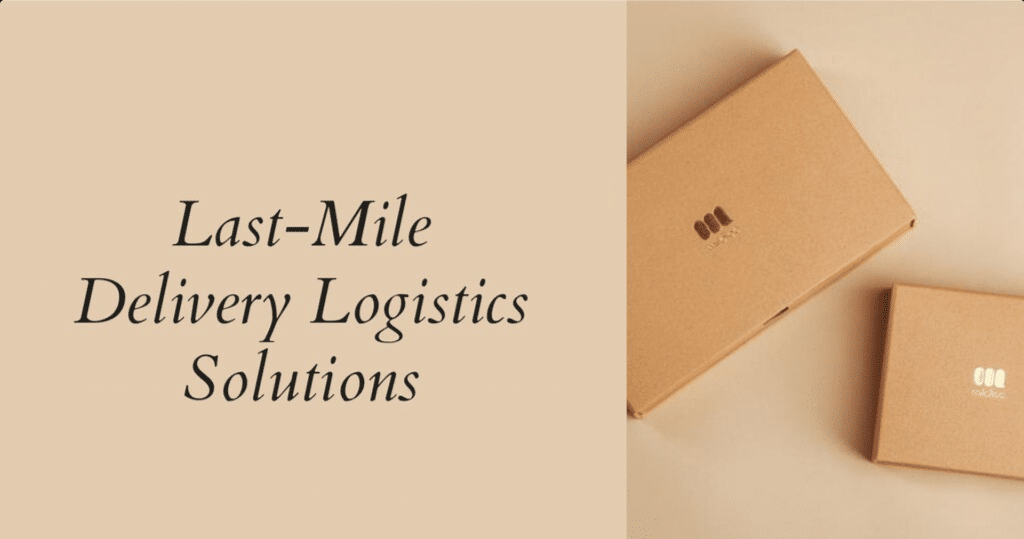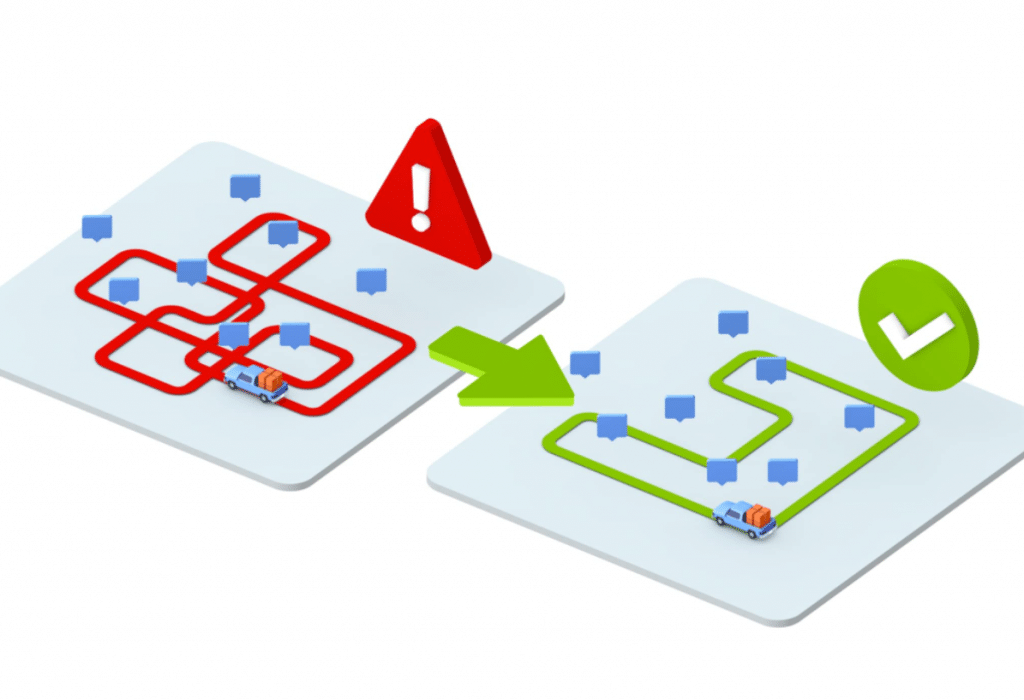The Best Last Mile Delivery Logistics Solution

A product’s journey from a warehouse shelf to a delivery truck to a customer is called the “last mile” of delivery. This is the point of arrival of the package at the end user’s doorstep. The last mile is one of the most expensive and time-consuming parts of the shipping process, in addition to being a necessity for customer satisfaction.
Companies must overcome bottlenecks and deliver items on time while dealing with the last mile as the most challenging and expensive part of logistics. In addition, the pandemic only accelerated consumer buying patterns that were already changing. It doesn’t matter if they’re ordering a prescription, flowers, or dinner, consumers today expect fast, free delivery.
We’re going to explore which industries use last mile delivery software in this guide and help you select the best last-mile delivery logistics solution for your company.
Last Mile Delivery
When you ship a parcel from a fulfillment center to a final destination, which is usually a residence, you are speaking of last mile delivery.
Consumers expect to receive their products quickly, so it’s the most critical step in the delivery process. It is also the most costly.
How are last mile delivery logistics used by different industries?
Here are some of the primary industries using last mile delivery logistics solutions, though this list is not exhaustive.
Pharmacy
Those days are gone when you went to your local pharmacy or a chain pharmacy like Walgreens. Pharmacies also experienced a decrease in foot traffic as a result of the pandemic, as many other industries did.
Prescriptions are now being delivered to customers, sometimes on demand. This has its advantages, such as …
- The management of inventory accurately.
- Reducing the number of prescriptions returned (when patients fail to pick up their prescription).
- Allowing pharmacists to consult more freely.
It is not without its challenges, though.
To protect their customer base and brand, pharmacies need low overhead costs, compliant software, and responsive, reliable customer service. They can either work with third-party couriers or handle in-house deliveries.
Rx Delivered Now, for example, adheres to federal, state, and local regulations. Additionally, patients can trust their pharmacists to deliver their prescriptions on time.
Construction
For building materials to arrive on-site, last mile delivery logistics are vital.
Using materials delivery software, contractors and construction site managers can better schedule jobs, match materials with craftsmen, and ensure drivers locate their sites efficiently. In addition, they won’t need to store excess materials.
To use an example, TOOLBX’s all-in-one platform for procurement of construction materials ensures that orders are delivered directly to the construction site on the same day they are placed.
Using TOOLBX, a driver can deliver construction materials.
Cannabis
Sales of cannabis are expected to reach $33.6 billion by 2025, a phenomenal growth rate.
There are still some states that do not allow brick-and-mortar dispensaries, so last mile cannabis delivery is vital to growth.
An increase of 300% was seen in curbside pickups and home deliveries during the pandemic.
A Nevada company called Blackbird provides delivery services to small cannabis businesses.
Most large cannabis dispensaries utilize an in-house delivery management software or a logistic software vendor – like MileNow- in order to manage last mile deliveries.
Managing drivers, planning routes, fulfilling deliveries, and complying with marijuana delivery laws are all made easier with cannabis delivery software.
Floral
You can order flowers from companies such as FTD, Teleflora, or 1-800-Flowers.
BloomNation is a newer player with about 3,500 florists who deliver to nearly 5,000 cities. When customers search online for flowers, they can contact local florists directly using the florist’s direct site or the BloomNation marketplace.
In order to make customers happy with their flower deliveries, BloomNation’s ecommerce software integrates smoothly with Onfleet’s developer-friendly API.
Grocery
The company began offering home delivery and curbside pickup in 2016, at the same time it expanded into 14 new markets. These new services were not heavily marketed by leadership. Because they wanted to make sure they could meet demand first. They turned to MileNow for help.
As a result of MileNow, the company reduced costs by 45% per year and improved route efficiency.
Restaurants
Prior to COVID, people preferred to dine on-premises. Nowadays, they prefer to eat in the comfort and safety of their homes.
Restaurants needed to change rapidly to stay in business. Restaurants still need a reliable way to deliver food, even if they accept orders online. In addition, as more restaurants offered delivery services, there were fewer third-party drivers available.
To boost customer loyalty and maintain lower delivery costs, Original ChopShop and bellagreen in Texas hired their own drivers and partnered with MileNow to offer home delivery service. Almost immediately, direct orders increased and negative feedback decreased.
Common Challenges in Last Mile Delivery Logistics
Last mile delivery is a complex stage in the logistics process that often brings more problems than any other part of the supply chain. As consumer expectations grow, businesses face increased pressure to offer faster delivery without passing on additional costs. This step might look simple on the surface, but it presents a range of challenges that are difficult to solve with traditional methods.
One of the most common problems is route inefficiency. Without optimized routes, drivers spend more time in traffic or take longer paths, which leads to higher fuel costs and delays. Unplanned routes also make it difficult to meet tight delivery windows, especially in urban areas with heavy congestion.
Another issue is customer availability. Failed delivery attempts are expensive and frustrating. If a customer is not home or if access is restricted, the delivery fails. This results in extra trips, more labor costs, and a poor experience for the customer. Missed deliveries also put pressure on drivers and reduce the number of successful orders they can complete in a shift.
Lack of visibility is another major concern. When logistics teams cannot see where drivers are, they have limited control over the delivery experience. This also affects customer service. If a customer calls to ask about the status of their order, the support team may not have the answers. Without live tracking, it becomes difficult to update customers on changes or delays.
Communication gaps between dispatchers, drivers, and customers add another layer of difficulty. If updates are not sent automatically, dispatchers must call drivers or customers manually. This slows down operations and increases the risk of errors. Delivery software should allow for clear, real-time communication that reduces back-and-forth and helps everyone stay informed.
Handling a growing volume of deliveries can also create operational stress. As businesses grow, they need to process more orders with the same resources. Manual systems often can’t keep up, leading to bottlenecks, mistakes, or missed delivery windows. Without automation, dispatching and planning take too long, especially when dealing with multiple drivers or complex schedules.
Security and compliance also matter. In sectors like healthcare, cannabis, and pharmaceuticals, delivery teams must follow strict legal and safety standards. Without proper tracking, proof of delivery, and secure handling processes, businesses risk penalties and customer trust issues.
Lastly, reverse logistics is often overlooked. When customers want to return items, the last mile process needs to work in reverse. Many companies struggle to manage returns quickly and accurately without disrupting daily operations.
Solving these challenges requires a system that is flexible, scalable, and designed specifically for last mile delivery. With the right technology in place, companies can reduce costs, improve service, and meet customer expectations without overburdening their teams.
What to Look for in a Last Mile Delivery Platform
Choosing a last mile delivery platform requires a thoughtful approach. The right solution should improve your operations without requiring a complete overhaul of your existing systems. As delivery becomes a more important part of the customer experience, businesses need tools that are reliable, easy to use, and designed for growth.
The first feature to consider is route optimization. A strong platform will calculate the most efficient path for each delivery, taking into account traffic conditions, time windows, and delivery zones. This helps reduce fuel use, improve driver productivity, and ensure packages arrive on time. Instead of relying on manual planning or generic maps, logistics teams can use smart tools to get accurate routes with minimal effort.
Real-time driver tracking is another essential feature. It gives dispatchers visibility into where each driver is, which helps them answer customer queries quickly and respond to unexpected issues. If a driver gets delayed or takes a wrong turn, the system alerts the team so they can adjust plans or update customers. It also creates a sense of accountability, since drivers know their movements are being tracked.
Automated dispatching is helpful when managing multiple deliveries or a large team of drivers. A platform that uses auto-assignment can match drivers with the right orders based on location, capacity, or availability. This removes the guesswork from planning and helps reduce the workload on dispatch teams.
The platform should also support clear communication between the customer, driver, and dispatcher. Sending automatic SMS or email updates at each stage of delivery builds trust and keeps the customer informed. A good system also lets drivers message customers directly or send delivery confirmation once the item has arrived.
Proof of delivery features, such as digital signatures, photo capture, or barcode scans, are becoming more important. These tools reduce disputes, protect drivers from false claims, and help businesses maintain accurate records. This is especially important for industries that deliver high-value or sensitive products.
Integration is another key factor. The last mile platform should connect easily with your existing order management or ecommerce systems. Whether you use Shopify, WooCommerce, or a custom ERP, integration helps reduce data entry errors and speeds up processing. APIs, CSV imports, and automation tools like Zapier allow for flexible setup based on your needs.
Analytics and reporting features help teams monitor performance over time. You can track key metrics like on-time delivery rates, customer satisfaction, and delivery completion times. With these insights, you can identify patterns, make informed decisions, and improve weak areas.
Finally, consider the user experience. The platform should be easy to learn for drivers, dispatchers, and admins. If it takes too long to train your team or if the interface is confusing, adoption will be low. Choose a solution with a simple layout, mobile access, and responsive customer support.
By focusing on these core elements, businesses can find a delivery platform that improves efficiency and supports long-term growth. A strong system doesn’t just help you meet today’s demand; it prepares you to scale as your customer base and delivery volume expand.
Mile: The Best Last Mile Delivery Solution
Here we will look at some of the key elements of a last mile delivery logistics solution.
Auto Assignment
Every last mile logistics solution must have an Auto-Assignment feature. This technology helps reduce the amount of time it takes to deliver a product on the last mile and the labor costs associated with it.
An automated dispatch management system could increase profits by over 12%, improve vehicle utilization by 13%, and reduce travel time by 15%, according to ABI Research.
Route Optimization
Routing optimization reduces delivery time by finding the fastest and most efficient routes. For the most efficient last mile routing, it takes into account time, location, capacity, and traffic. Additionally, you can alert your drivers about any last-minute changes to their routes so they can avoid traffic delays.
With route optimization, you can:
- Visualize the delivery routes
- to reduce delivery times
- and eliminate bottlenecks
- to improve customer service
- Reduce vehicle and fuel costs

Driver & Customer Communication
During the last mile delivery, keep in touch with your drivers and customers. In order to ensure your customers are delighted.
To begin with, you can send automatic SMS updates to let your customers know when their delivery has started when it will arrive, and when it has arrived.
To check on the progress of their order, customers can call, message, or call the dispatcher.
Driver Tracking
Tracking drivers in real-time allows dispatchers to find out where they are and get ETAs for deliveries in the last mile. When they need to notify customers of potential delays or reset expectations, this function is extremely helpful. Also, in case the initial driver is late returning to the depot, delivery managers are able to replan routes.
Read More: Top last mile delivery companies
E-Signatures & Proof of Delivery
In order to protect their drivers and customers, delivery firms focused more on contactless signatures and proof of delivery over the pandemic. Drivers can collect photos, signatures, and barcodes on the spot using MileNow’s proof of delivery feature.
Analytics/Reporting
By using the analytics and reporting features, you can analyze performance and find key insights, such as the number of successful deliveries versus failed deliveries, the performance of the drivers, and their resource usage.
As an example, MileNow gives you the ability to visualize delivery success rates, on-time rates, service times, customer feedback scores, and distance traveled. Additionally, for a complete performance overview, you can segment data by driver, team, day, week, and even hour.
You can use this information to proactively avoid delays and missed or failed deliveries.
Feedback Collection
Additionally, you should ensure that your last mile delivery logistics solution enables you to collect customer feedback. After each delivery, you can gather firsthand feedback from your customers through a feedback form.
Ratings and reviews from customers help you identify issues with your software and improve it.
Platform Integrations
In addition, you should make sure that the last mile logistics solution can be integrated with other platforms, such as ERP or time management systems.
The MileNow platform, for instance, allows you to import CSV or Excel files or to use Zapier to connect to hundreds of third-party applications, including Shopify and Google Sheets. You can also integrate the API with your applications using the developer-friendly interface.
Start Using The Leading Last Mile Delivery Logistics Solution
MileNow offers leaner operations, intelligent decisions, and an enjoyable customer experience as the world’s most advanced last mile delivery platform.
With MileNow, you’ll get auto-assignment, driver tracking, route optimization, and feedback collection, among other useful features. Start your free 14-day trial today and discover how MileNow has the features you need to implement your last mile delivery logistics.
Read More: Pharmacy Delivery: Challenges, Trends and Solutions

